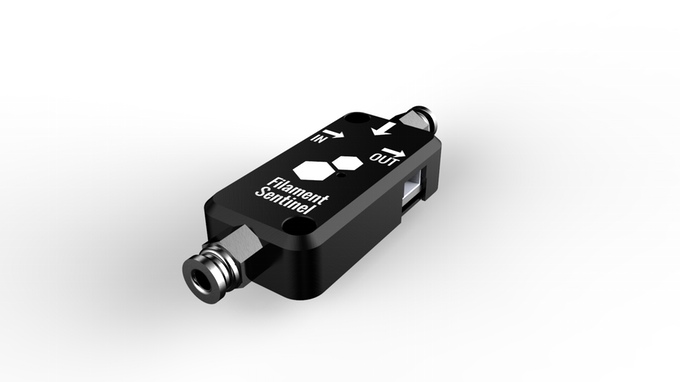
A Montreal-based company has launched a 3D printing accessory that detects out-of-filament conditions.
The “SENTINEL” is from Dyze Design, a company that has produced a number of unique desktop 3D printer accessories and upgrade components. In fact, we wrote on their powerful DyzeXtruder only a few months ago.
The SENTINEL is a very simple accessory that attempts to detect when your filament runs out. This is a very common problem among 3D printer operators, because with the introduction of increasingly reliable machines, operators tend to print larger and longer. This increases the odds of running out of filament significantly.
Unfortunately, most desktop 3D printers do not have any mechanism to detect and take action when filament runs out. Very often you’ll enter your workshop in the morning, only to find the machine has been “printing air” for the last two hours of a 38 hour print. Very Frustrating.
The idea with SENTINEL is to detect the out of filament condition and then signal the 3D printer to pause. This enables the operator to properly replace the empty spool with fresh material and resume printing.
There are a few systems that include this functionality in their devices, mostly by using chipped material cartridges: they simply count the amount of material used per cartridge and report when it’s insufficient to continue. SENTINEL is a bit different, in that it causes an actual pause in printing operations.
The device has a light sensor that “sees” whether filament is passing through. If not, a light goes on and a signal is transmitted to the nearby 3D printer.
But this is where it gets a bit tricky. It’s relatively easy to detect the filament is gone, but more problematic in getting the 3D printer to act appropriately once done.
Dyze Design’s concept is that you must tweak your 3D printer’s firmware to enable this feature to work. And I’m sure it does.
However, the approach will only work on open source machines where you can actually access the firmware to make modifications. That cuts down the applicability of this device somewhat among the population of desktop 3D printers.
Power to the SENTINEL is provided by your 3D printer’s control board through a cable. No batteries are required, which is a good thing as the SENTINEL is smaller than common batteries.
The SENTINEL appears to be a well-built, robust unit. And you can even chain them together for added reliability: an out-of-filament signal is sent only if ALL of the SENTINELs agree.
Pricing is inexpensive at only CAD$35 (USD$26) each, and rising as sales are made. They’re expecting the retail price to be approximately CAD$45 (USD$33.50), so anyone can afford this.
And who wouldn’t want to?
Via Dyze Design and Kickstarter

